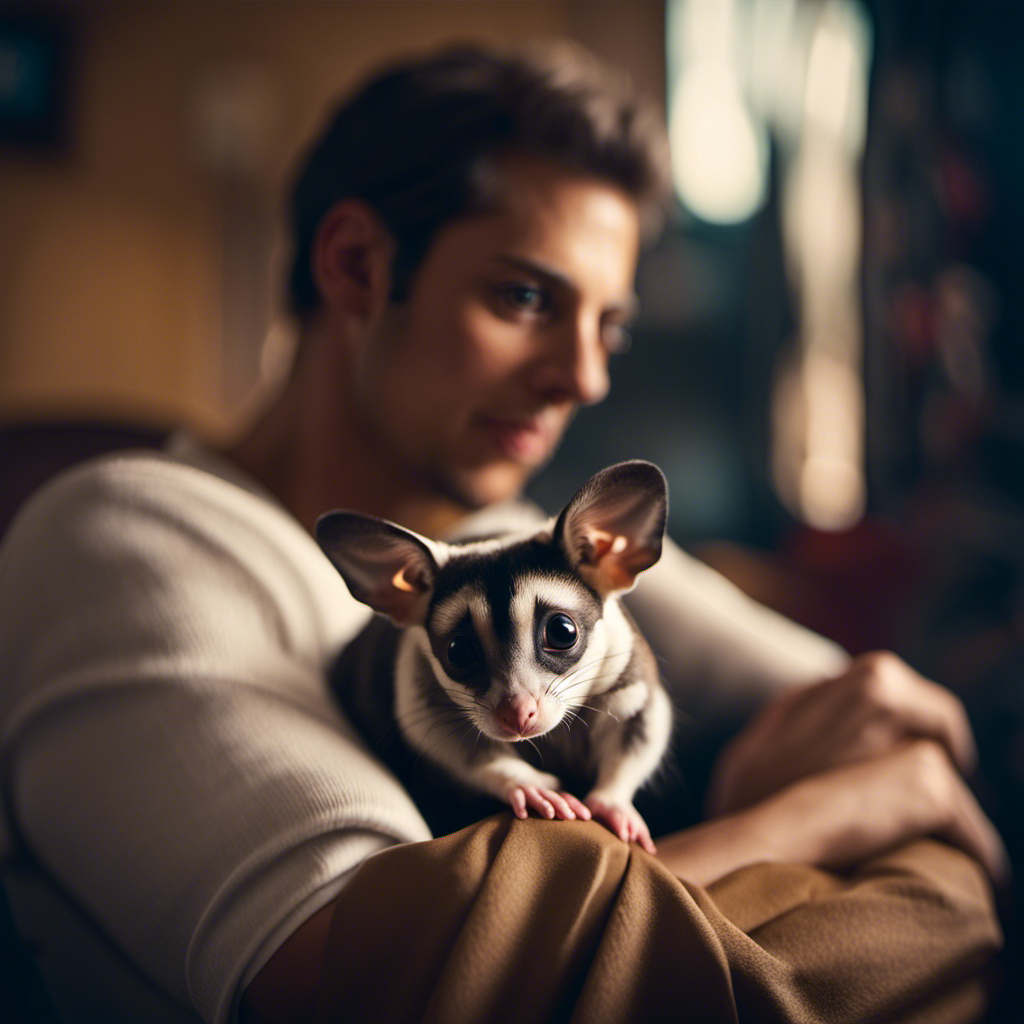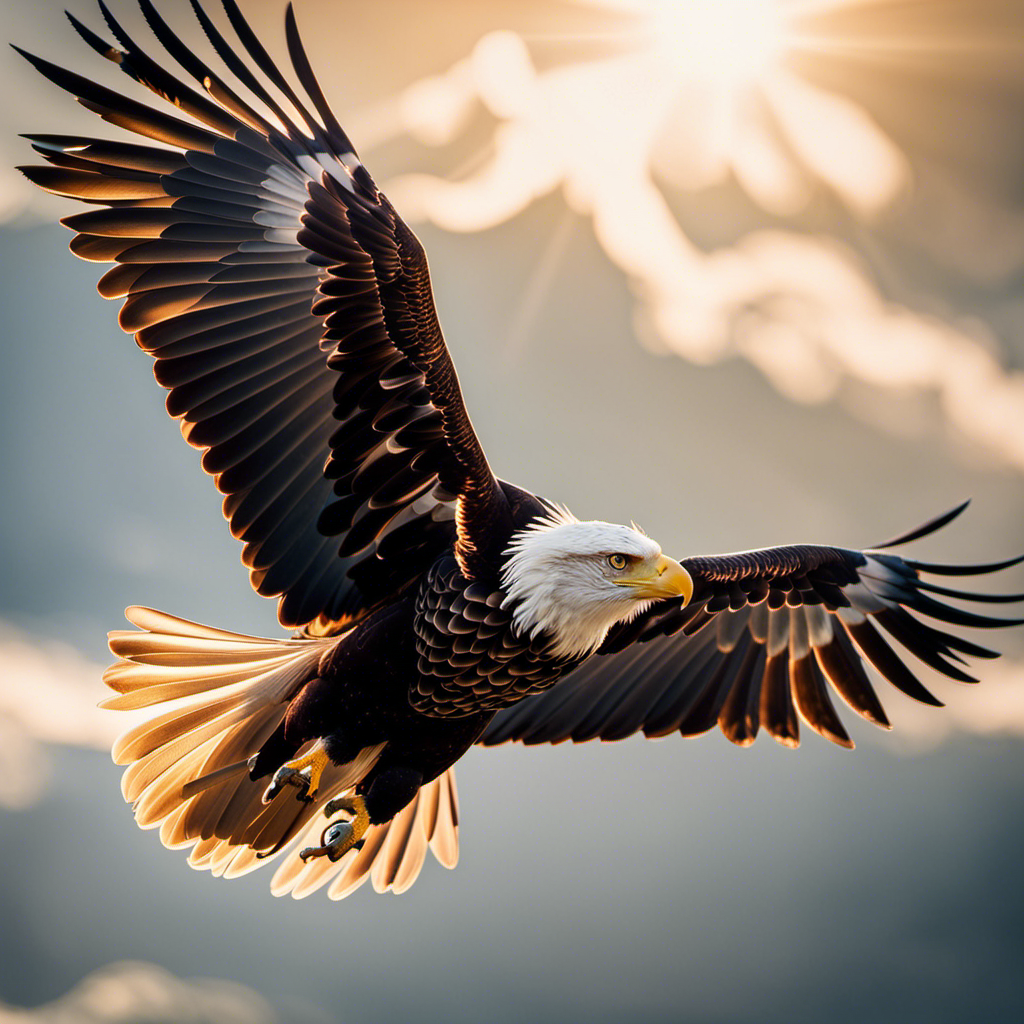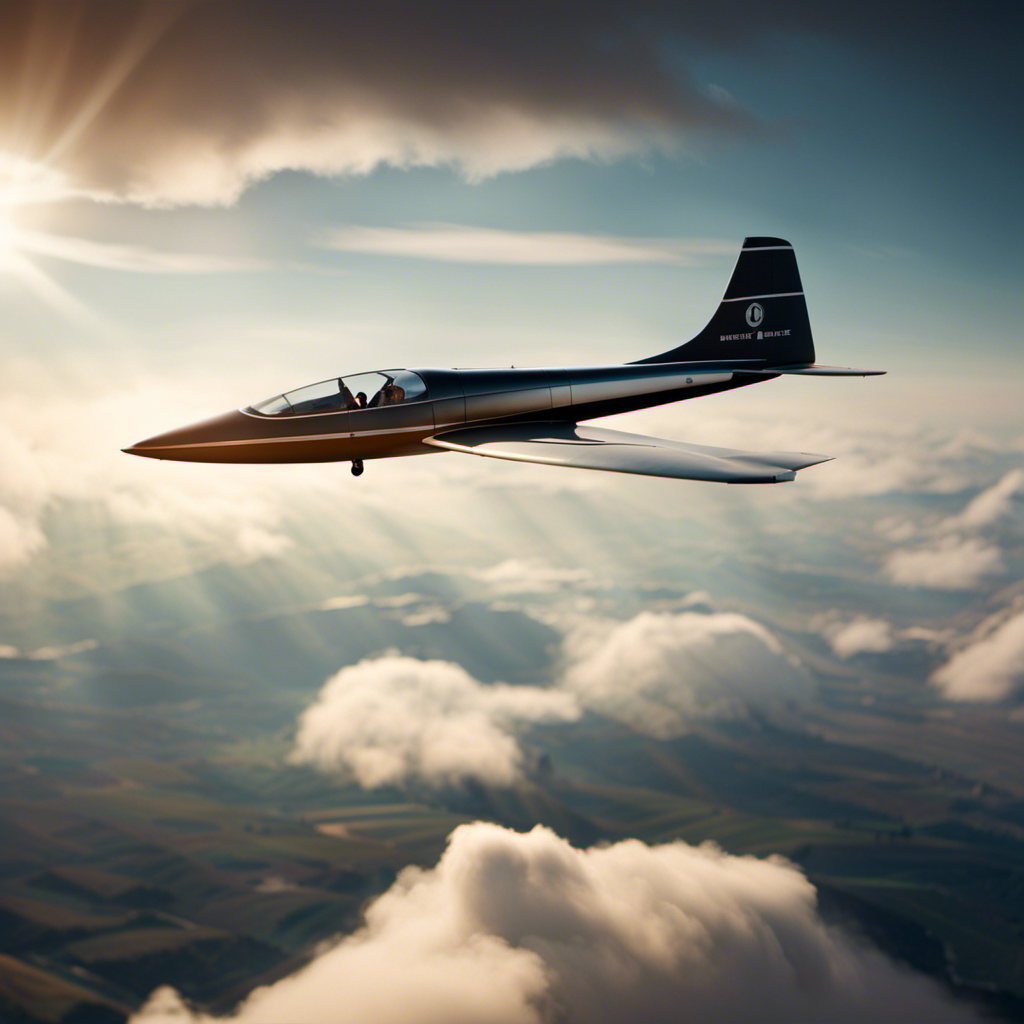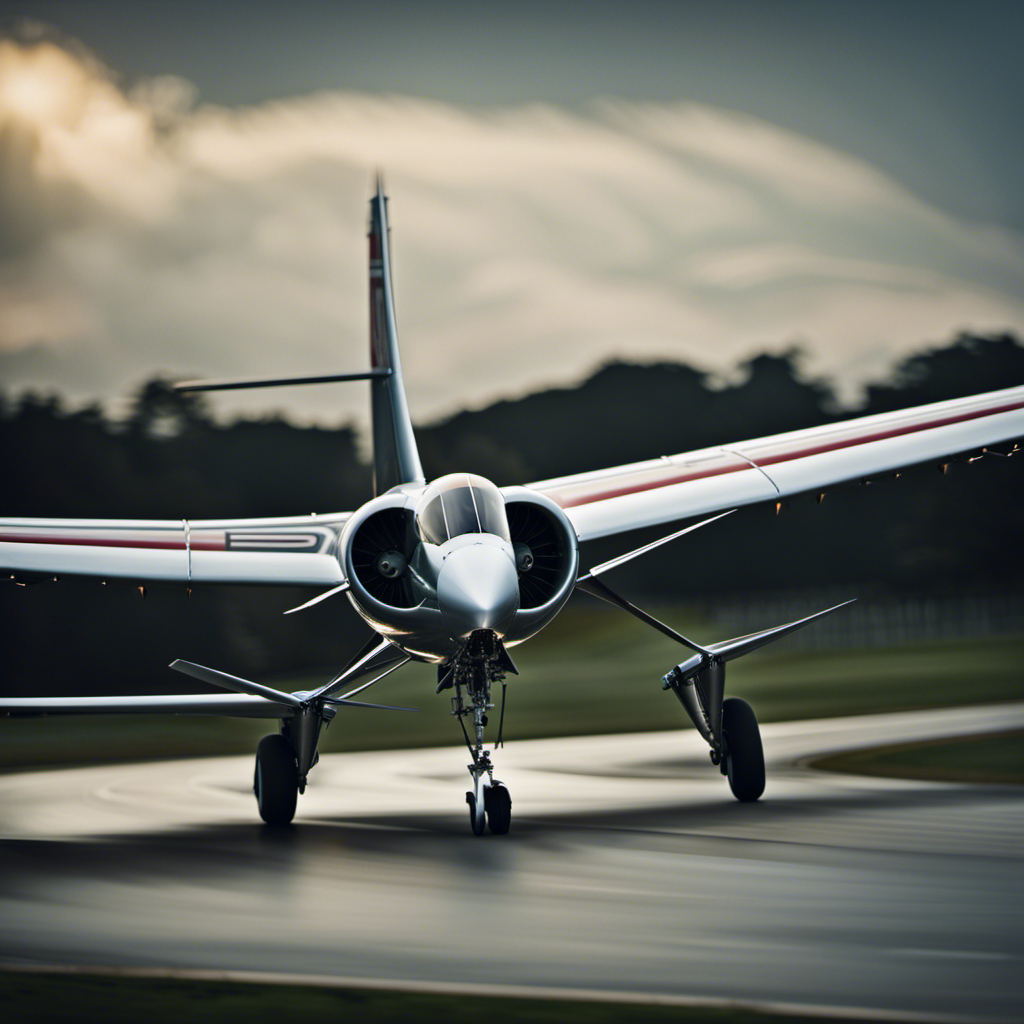As a pet lover, I have always been fascinated by the idea of having a unique and adorable companion. That’s why sugar gliders have piqued my interest – these small marsupials with their cute big eyes and ability to glide are just too charming to resist.
In this article, we will explore whether sugar gliders make good pets. We’ll cover their size and lifespan, behavior, socialization needs, diet and nutrition, potential challenges, and the costs involved.
So, let’s delve into the world of sugar gliders and find out if they’re the right pet for you.
Key Takeaways
- Sugar gliders require a significant time commitment for socialization and bonding.
- A balanced diet and exercise are essential for their well-being as they grow older.
- Socialization with other gliders is crucial for their overall well-being.
- Sugar gliders may require specialized diets and supplements.
Introduction to Sugar Gliders as Pets
If you’re considering getting a pet, sugar gliders can be a unique and interesting choice. These small marsupials are native to Australia and Indonesia and have become increasingly popular as pets in recent years.
One of the key factors to consider when thinking about getting a sugar glider is their size and lifespan. Sugar gliders are small creatures, typically measuring around 6 to 7 inches in length and weighing between 4 to 6 ounces. In captivity, they can live up to 12-15 years with proper care.
Understanding their behavior is also crucial before bringing them home. Sugar gliders are social animals that thrive in pairs or small groups, so it’s essential to provide them with plenty of social interaction and mental stimulation.
Now, let’s explore the size and lifespan of sugar gliders in more detail.
Size and Lifespan of Sugar Gliders
When considering getting one, you should know that sugar gliders are small creatures, weighing only around 4 to 5 ounces and measuring about 6 to 7 inches in length. Despite their small size, they can live for quite a long time, with a lifespan of around 10 to 15 years.
It’s important to understand that as they age, their needs may change, requiring adjustments in their diet and environment. Providing them with a balanced diet and plenty of exercise is essential to ensuring their well-being as they grow older.
Understanding the size and lifespan of sugar gliders is crucial when deciding if they are the right pet for you. Now, let’s delve into understanding their behavior and how to create a suitable environment for them.
Understanding Sugar Glider Behavior
Understanding the behavior of sugar gliders is essential to creating a suitable environment for them. These adorable creatures have unique behaviors that require special attention and care. Here are four important aspects of sugar glider behavior that every owner should be aware of:
-
Nocturnal Nature: Sugar gliders are nocturnal animals, meaning they are most active during the night. It’s important to provide a quiet and dark space for them to sleep during the day.
-
Social Animals: Sugar gliders are highly social animals and thrive in the company of their own kind. They should always be kept in pairs or small groups to prevent loneliness and ensure their well-being.
-
Bonding Process: Bonding with sugar gliders requires time, patience, and consistency. It’s important to establish trust through gentle handling and positive reinforcement.
-
Playful and Active: Sugar gliders are energetic and love to play. Providing them with plenty of toys, climbing structures, and opportunities for exercise is crucial for their physical and mental health.
Understanding sugar glider behavior is just the first step towards creating a happy and fulfilling life for these amazing creatures. Now, let’s dive into the importance of socialization for sugar gliders.
The Importance of Socialization for Sugar Gliders
To ensure a happy and well-adjusted sugar glider, it’s crucial that you prioritize socialization with other gliders. Sugar gliders are highly social animals and forming bonds with their own kind is essential for their overall well-being. Socialization provides them with opportunities for play, communication, and learning important skills from their peers. By interacting with other gliders, they develop important social behaviors and form strong bonds that help reduce stress and anxiety.
Here is a table showcasing the benefits of socialization for sugar gliders:
| Benefits of Socialization for Sugar Gliders |
|---|
| 1. Promotes mental stimulation and enrichment |
| 2. Helps develop social skills and behaviors |
| 3. Reduces stress and anxiety |
| 4. Provides opportunities for play and exercise |
Diet and Nutrition for Sugar Gliders
Feeding a proper diet and ensuring adequate nutrition is crucial for the health and well-being of your furry little companions. When it comes to sugar gliders, their diet is an important aspect of their overall care. Here are some key points to consider when it comes to sugar glider diet and nutrition:
- A balanced diet for sugar gliders should consist of a variety of fruits, vegetables, proteins, and insects.
- Pelleted diets specifically formulated for sugar gliders can also be included as part of their diet.
- It is important to avoid feeding sugar gliders foods that are high in sugar, fat, and salt.
- Calcium and phosphorus are essential for their bone health, so incorporating foods rich in these minerals is important.
- Provide fresh water at all times to keep your sugar gliders hydrated.
By ensuring a proper diet and nutrition for your sugar gliders, you can contribute to their overall health and well-being.
Now, let’s move on to the next section, which focuses on the housing and cage setup for sugar gliders.
Housing and Cage Setup for Sugar Gliders
When setting up the housing and cage for your sugar gliders, it’s important to create a safe and stimulating environment. Sugar gliders are active and curious animals that need plenty of space to climb, glide, and explore. The size of the cage is crucial to their well-being. A minimum cage size of 24′ x 24′ x 36′ is recommended for a pair of sugar gliders. This ensures they have enough room to move around and engage in natural behaviors.
Additionally, it’s important to provide various enrichment activities to keep them mentally and physically stimulated. This can include toys, tunnels, branches, and hammocks. By providing a spacious cage and enrichment activities, you are creating a comfortable and engaging home for your sugar gliders.
As we continue to discuss exercise and enrichment for sugar gliders…
Exercise and Enrichment for Sugar Gliders
You can provide exercise and enrichment for your furry friends by setting up a glider wheel and arranging various climbing structures in their cage.
Sugar gliders are active animals and need regular physical activity to stay healthy and happy. A glider wheel allows them to run and play, mimicking their natural behavior of jumping and gliding through trees.
Additionally, providing climbing structures such as branches or ladders helps to simulate their natural habitat and encourages them to explore and exercise their climbing skills. These exercise routines not only keep their bodies fit but also provide mental stimulation, preventing boredom and promoting overall well-being.
Now that we have covered the importance of exercise and enrichment, let’s move on to the next section about veterinary care and health considerations for sugar gliders.
Veterinary Care and Health Considerations
Regular veterinary check-ups are essential for maintaining the health and well-being of your furry companions. When it comes to sugar gliders, these small marsupials require specialized care to ensure they stay healthy and happy. Here are some important health considerations to keep in mind:
| Health Consideration | Description | Importance |
|---|---|---|
| Diet | Sugar gliders have specific dietary needs, including a balanced mix of fruits, vegetables, and protein. | High |
| Dental Care | Regular dental check-ups are crucial to prevent dental issues and maintain proper oral hygiene. | Medium |
| Parasite Prevention | Sugar gliders can be susceptible to parasites, so it’s important to use appropriate preventatives. | Medium |
| Vaccinations | Keeping up with vaccinations is essential to protect your sugar glider from common diseases. | High |
| Environmental Factors | Providing a safe and clean living environment is vital to prevent health issues. | High |
Bonding and Building Trust with Your Sugar Glider
Building trust with your sugar glider is essential for creating a strong bond and ensuring a positive relationship. Sugar gliders are social animals and thrive on companionship, so it is crucial to establish trust early on.
One of the most effective ways to build trust is through socialization techniques. Spend quality time with your sugar glider, allowing them to become familiar with your scent and voice. Start by offering treats from your hand and gradually progress to holding and petting them. It is important to be patient and gentle, as sugar gliders can be skittish at first.
By consistently using positive reinforcement and providing a safe and comfortable environment, you can develop a deep bond with your sugar glider.
Now, let’s move on to the legal considerations for owning a sugar glider.
Legal Considerations for Owning a Sugar Glider
Before deciding to bring a sugar glider into your home, it is important to research and understand the legal requirements involved in owning one.
These adorable creatures are not legal to own in all areas, so it is crucial to check with your local authorities and ensure that you are allowed to have a sugar glider as a pet. Some states or countries may have specific regulations or restrictions in place, such as permits or licenses.
Additionally, it is essential to be aware of the care requirements for sugar gliders. These small marsupials need a specialized diet, a spacious enclosure with plenty of climbing opportunities, and regular social interaction.
By understanding the legal restrictions and care requirements, you can provide a suitable and legal environment for your sugar glider.
Now, let’s discuss the time and commitment required for these fascinating pets.
Time and Commitment Required for Sugar Gliders
Taking care of a sugar glider requires a significant amount of time and commitment. These adorable creatures may seem low-maintenance, but they have specific care requirements that must be met for their well-being. Here are a few key aspects to consider when it comes to the time commitment of owning a sugar glider:
-
Daily Interaction: Sugar gliders are social animals and require daily interaction with their owners. This includes playtime, bonding, and providing mental stimulation.
-
Diet and Nutrition: Their diet consists of a balanced mix of fresh fruits, vegetables, protein, and a specialized pellet diet. Preparing their meals and ensuring they have a varied and nutritious diet takes time and attention.
-
Cage Maintenance: Cleaning their cage regularly, providing fresh bedding, and ensuring a clean and safe environment is essential for their health.
Understanding the time commitment and care requirements of sugar gliders is crucial before bringing one into your home. Transitioning into the subsequent section about the potential challenges of owning a sugar glider, it’s important to be aware of the additional responsibilities and considerations that come with these unique pets.
Potential Challenges of Owning a Sugar Glider
Transition: Now that we have discussed the time and commitment required for owning a sugar glider, let’s delve into the potential challenges that come with these adorable marsupials.
Current Subtopic: Potential Challenges of Owning a Sugar Glider
While sugar gliders make fascinating pets, it is important to be aware of the challenges that may arise. One of the main challenges is their specialized care requirements. Sugar gliders have a unique diet consisting of fresh fruits, vegetables, insects, and a balanced pellet food. Ensuring they receive the proper nutrition can be time-consuming and expensive.
Additionally, sugar gliders are social animals and require plenty of interaction and mental stimulation. This means spending dedicated time with them daily, providing toys, and creating a safe environment for them to explore. Furthermore, these nocturnal creatures can be noisy at night, which may disrupt your sleep schedule.
Despite these challenges, the rewards of owning a sugar glider can outweigh the difficulties.
Transition: With an understanding of the challenges involved, it is important to also consider the cost of owning a sugar glider.
Cost of Owning a Sugar Glider
To properly care for a sugar glider, you’ll need to consider the financial implications. While sugar gliders themselves can be relatively affordable, the cost of their care can add up over time. It’s important to compare the costs of purchasing a sugar glider with the ongoing expenses of providing for their needs.
This includes the cost of their enclosure, food, toys, bedding, and veterinary care. Additionally, sugar gliders have a long lifespan, which means you’ll need to be prepared for the financial responsibilities that come with their care for many years. When considering the cost of owning a sugar glider, it’s essential to budget for these expenses to ensure you can provide for their well-being.
However, if the financial commitments of owning a sugar glider are a concern, there are alternative pets for consideration that may be more suitable for your situation.
Alternative Pets for Consideration
If you’re considering other options, there are plenty of alternative pets that might be a better fit for you. While sugar gliders can make great companions, they are not for everyone. If you’re looking for something a little more unconventional, there are several other pets to consider.
One option is a hedgehog. These small, spiky creatures can be quite low maintenance and can be easily handled. Another alternative is a reptile, such as a leopard gecko or a bearded dragon. These reptiles require specific care, but can be fascinating pets to observe.
However, it’s important to weigh the pros and cons of these unconventional pets. Each one has its own unique needs and characteristics, so be sure to do your research before making a decision.
Transition: Now that we’ve explored some alternative pets, let’s delve into the question of whether a sugar glider is the right pet for you.
Conclusion: Is a Sugar Glider the Right Pet for You?
Now that we’ve explored other options, it’s important to consider whether a sugar glider is the right choice for you.
Sugar gliders can make wonderful pets, but they require a significant amount of time, attention, and special care. Building a bond with a sugar glider takes patience and dedication.
These small marsupials are social creatures that thrive on interaction and companionship. They need daily exercise and mental stimulation, as well as a balanced diet that includes fresh fruits and vegetables.
It’s also crucial to address the legal restrictions surrounding sugar gliders. While they are legal to own in some states and countries, others require permits or prohibit ownership altogether.
Before getting a sugar glider, make sure to research and understand the laws in your area to ensure you can provide a safe and legal home for these unique pets.
Frequently Asked Questions
Can sugar gliders be trained to use a litter box?
Yes, sugar gliders can be trained to use a litter box. Start by placing the litter box in a corner of their cage. Use positive reinforcement and consistency to encourage them to use it. It may take some time and patience, but it is possible.
Are sugar gliders prone to any specific health issues?
Sugar gliders can be prone to health issues if their diet is not balanced. It’s important to provide them with a varied diet that includes fruits, vegetables, insects, and a specialized sugar glider diet. They can also be affected by common parasites such as mites and ticks.
How much exercise do sugar gliders need on a daily basis?
Sugar gliders in captivity need at least an hour of exercise daily to stay healthy. This can include supervised playtime in a safe, enclosed space, or the use of exercise wheels. Providing mental stimulation, such as toys and puzzles, is also important for their well-being.
Can sugar gliders be kept in pairs or do they need to be housed individually?
Sugar gliders are social animals and thrive when kept in pairs. They provide companionship to each other, reducing loneliness and stress. Having a pair allows them to engage in natural behaviors, promoting their overall well-being.
Are there any legal restrictions on owning a sugar glider in certain areas?
Legal considerations for owning a sugar glider vary by location. It’s important to research local laws and regulations before getting one as a pet. Potential dangers include improper care, injuries from falls, and the need for a specialized diet.
Conclusion
In conclusion, after learning about the size and lifespan of sugar gliders and understanding their behavior and the importance of socialization, it is clear that sugar gliders require a significant commitment.
Additionally, considering the diet and potential challenges of owning one, it becomes evident that sugar gliders are not low-maintenance pets. While they can make fascinating companions, their unique needs and costs should be carefully considered.
If you’re ready to embark on a rewarding journey filled with bonding and adventure, a sugar glider may just be the perfect pet for you. So spread your wings and soar into the world of sugar gliders!
Orion, better known as “Jetstream,” is the voice that brings the stories of the skies to life. His fascination with aviation began at a young age, sparked by his father’s tales of flying and adventure. Orion’s journey into the world of gliding was serendipitous, and from the moment he took his first glider flight, he knew he had found his calling.










